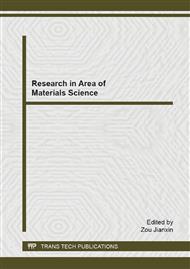[1]
C. Kajdas, Major Pathways for used oil disposal and recycling. Part 1, Tribotest7 (2000) 61-74.
DOI: 10.1002/tt.3020070107
Google Scholar
[2]
M. Rahman, T. Siddique, S. Samdani, K. Kabir, Effect of operating variables on regeneration of base-oil from waste oil by conventional acid-clay method, Chem. Eng. Res. Bull. 12 (2008) 24–27.
DOI: 10.3329/cerb.v12i0.1494
Google Scholar
[3]
Chemistry and Technology of Lubricants, 2nded. Blackie Academic & Professional, London, p.306–319.
Google Scholar
[4]
D. Graziano, E. Daniels, Assessment of opportunities to increase the recovery and recycling rates of waste oils, Technical Report, ANL/ESD-29 Argonne National Lab., IL, United States, (1995).
DOI: 10.2172/109517
Google Scholar
[5]
Waste oil recycling using mixtures of polar solvents. Industrial & Engineering Chemistry Journal 44, 7854–7859.
DOI: 10.1021/ie0580452
Google Scholar
[6]
Improvement of the waste-oil-vacuum distillation recycling by continuous extraction with dense propane. Industrial & Chemistry Research Journal 46, 266–272.
DOI: 10.1021/ie060831z
Google Scholar
[7]
G. Ofunne, A. Maduako, C. Ojinnaka, Studies on the ageing characteristics of automotive crankcase oils, Tribol. Int. 22 (1989) 401–404.
DOI: 10.1016/0301-679x(89)90073-x
Google Scholar
[8]
Ofodu, C. Anosike, Variation in rheological properties of engine oil with usage, Global J. Eng. Res. 2 (2003) 95–100.
DOI: 10.4314/gjer.v2i1.18919
Google Scholar
[9]
W.T. Tsai, C.C. Lin, C.W. Yeh, An analysis of biodiesel fuel from waste edible oil in Taiwan, Renew. Sustain. Energy Rev. 11 (2007) 838–857.
DOI: 10.1016/j.rser.2005.05.005
Google Scholar
[10]
H. Yu-Lung, Analysis and comparison of regenerative technologies of waste lubricant, Wseas Trans. Environ. Dev. 3 (5) (2005) 295–309.
Google Scholar
[11]
L.L. Ping, A. Ripin, R.M. Yunus, F.C. Yee, Re-refining of base oil from used lubricant oil: a method to formulate efficient potassium hydroxide (KOH) effect, in: Proceedings of the Chemical and Process Engineering Conference, (CPEC'00), Singapore, 2000, p.1.
Google Scholar


